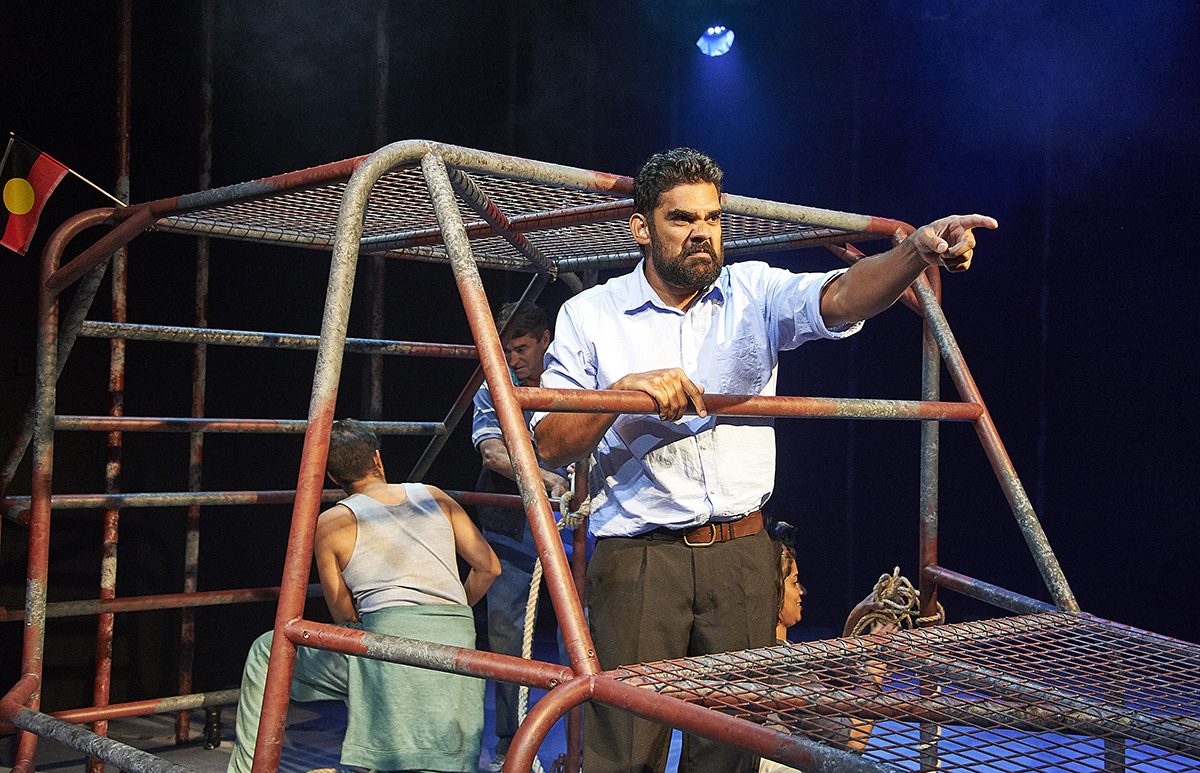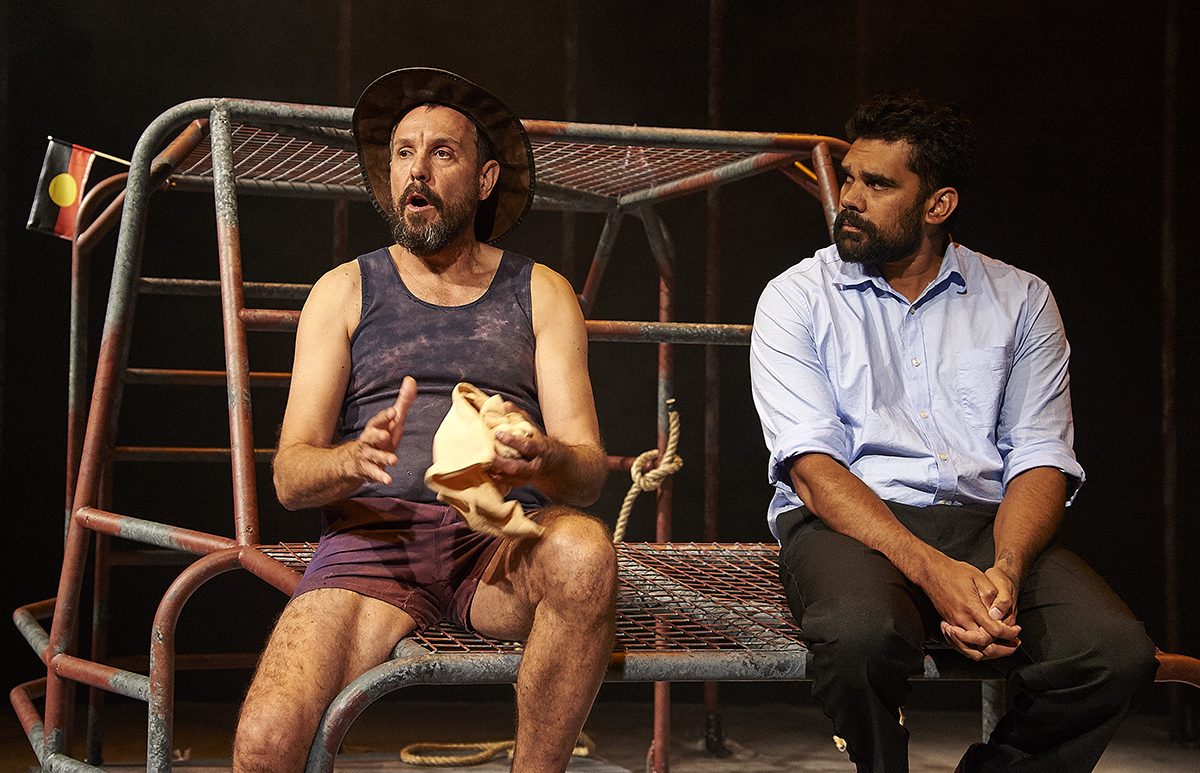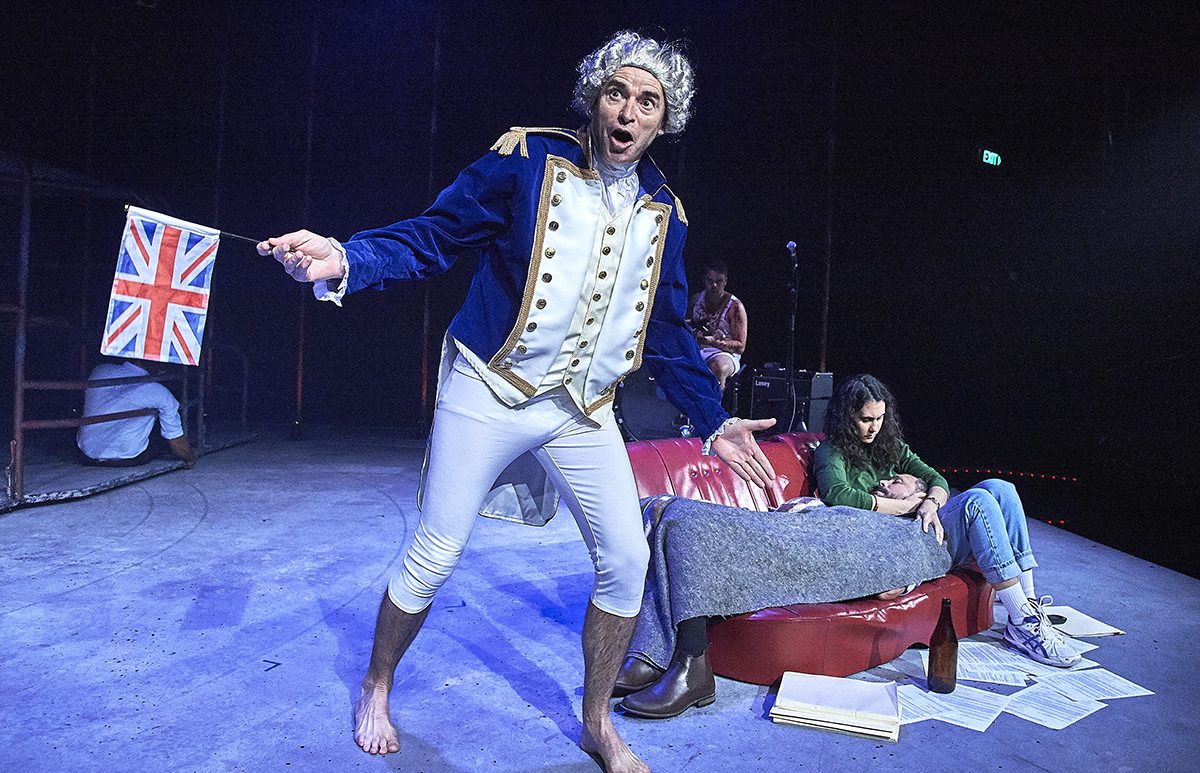Richard Frankland’s play Conversations With The Dead premiered 11 years after the 1987-91 Royal Commission into Aboriginal Deaths in Custody. The Commission published over 330 recommendations, including the promotion of self-determination through Indigenous representation and land rights. Since then the Mabo and Wik decisions have been watered down, ATSIC abolished, while Indigenous men and women continue to die in custody and by their own hands. On the 15th anniversary of the Commission publishing its findings, the Indigenous Affairs Minister insisted that such matters are up to states — despite the 1967 referendum that specifically empowers the federal government to make legislation applicable to Indigenous peoples.
While staging Conversations in 2002 seemed like a proclamation of angry mourning, watching it today after yet another 15 years of inaction and black deaths is liable to cause one to fall into the pitchest of pitch-black cynicism towards the potential of theatre, art and activism to have purchase on those situations needing intervention.
Yirra Yaakin may be refusing a reading of our sense of impotence, yet the production still prompts such questions. The 2002 premiere (reviewed by RealTime) should have been a wakeup call for a hideously uncaring, violent nation to get its shit together. But that did not happen, and it will not now. In the state where Conversations… is being performed we have Australia’s highest per capita Indigenous incarceration rate, only slightly below that in the US for black people.
In his opening night speech, author and former Royal Commission Investigator Frankland insists that when you have stories, you have hope. But it’s hard to entirely agree. In the play, Frankland’s alias, Jack, offers a seemingly endless series of self-excoriating reflections, repeatedly talking with the helpless, often angry ghosts who surround him. Beer bottles are a constant, and Jack relates how each day he counts the places from which he could hang himself. He is only safe when inebriated, in a corner, back to the wall, having located the exit route and identified all the weapons in the establishment (chairs, glass bottles etc). In one scene, he relates how a racist comment left him standing weeping over a bloodied, unconscious drinker.
Much of the action is performed in and around a metal car frame, or on an abandoned car seat. The play becomes a metaphorical road-trip performed by a man locked behind mental, historical and social bars as he careens through a landscape of mourning towards violent self-immolation. Jack does indeed find death, rushing into a storm at a seaside cliff, only to be tossed back into a tree, where he loses consciousness. The play is silent as to whether or not he wakes. Although one feels he should, in light of Australia’s never-ending race nightmare, the possibility that he will fall into a deathly coma cannot be ignored.
Two themes confuse this sorrowful reading, the main one being the mobility of the car itself. Australia has a history of road movies in which the protagonists traverse the fault-lines of race (eg Backroads, 1976, Beneath Clouds, 2002). The automobile set design for Conversations… symbolises not only a gaol cell (hung with socks such as those used by one man to hang himself) but also shifting bubbles of calm amid all the deaths invoked.
Jack is played by two actors: Maitland Schnaars and Alan Little. Jack works on a boat, and although the ropes and knots affixed to bars forecast the deathly nooses that blight his existence, in this sea-tossed cage ropes can be comfortably held and mastered. A similar emotional and corporeal ease occurs when Jack (now played by Little) converses with Uncle (Schnaars), who affectionately daubs the bars with a brush. Like the deceased body which both Schnaars and Little later wash clean of blood, the world they inhabit is treated with care.
The bleakness of the production is further countered by the sharing of roles. Schnaars excels at the presentational mode, speaking in third person about himself, while Little is more inward. Schnaars is tall and when his physicality lets go — as when he runs at the cliff — he funnels space, sucking it up and filling the room. Little is firmly grounded; more weighty than expansive. Not only Little and Schnaars speak for Jack. Simone Detourbet, otherwise playing the protagonist’s sympathetic yet exasperated wife, also voices him at one point, entering something like a fugue state beside the others.
In short, the performance extends and shares its affects and roles. Jack is not quite Richard Frankland, and nor — obviously — can he be me. I am both a spectator and a gubba. Yet the absent bodies of the dead, ghosted so effectively on stage, do seem spectrally exchanged and embraced in this work, even as they physically fend off the entreaties of the living characters and, by extension, us in the audience. There is no catharsis in Conversations With The Dead. The situation is too dire. And the masculine self-harm dramatised here is genuinely disturbing. The gravelly, DIY aesthetic seems to reflect this jagged, aggressive maleness, which is both Jack’s strength and his weakness. It too can be turned around and shared. The production functions then less as protest, and more as a collective remembering.
–
Yirra Yaakin Theatre, Conversations With the Dead, writer Richard Frankland, director James Taylor, performers Maitland Schnaars, Alan Little, Simone Detourbet, Peter Docker, Calen Tassone, Tornina Torres, design Chris Brain, lighting Chris Donnelly, music Zac James; Subiaco Arts Centre, Perth, 18-27 May
Top image credit: Alan Little, Tornina Torres, Conversations with the Dead, photo Jon Green
Over three days Perth’s MoveMe dance festival featured four major works, including the touring production of Force Majeure’s Never Did Me Any Harm. STRUT Dance, the National Choreographic Centre of Western Australia, provided the centrepiece, their young dancers performing under Batsheva Dance’s Artistic Director Ohad Naharin in a restaging of his Decadance (2000). The other two works I saw came from relatively new ensembles. New Zealander Raewyn Hill, who moved from Queensland’s Dancenorth to found Co3 in 2015, has made The Cry, while Praxis, a new collaboration comprising choreographer Laura Boynes, visual artist Alexander Boynes, composer Tristen Parr and five dancers premiered Dark Matter.
STRUT Dance: Decadance
Decadance is the most assured piece in the MoveMe program. STRUT’S dancers nail the complex, off-balance choreography. The work consists of 10 disparate studies of varying degrees of classicism. The choreography has a strong sense of line and precision, as well as an ambience of light sexual/erotic play (generally recalling Nederlands Dans Theater). Hip movements, especially from the women, often lead, and upright postures are broken by sweeping bends and crouches into the floor. The design is simple, including monochromatic, body-hugging jeans and tank tops. Pointe and partnering emerge, as do games with shoes. Arrayed in rows, dancers often run in parallel lines across the stage. When unison arises, the rippling responses recall a great machine, pushing the work into a focused ecstasy.
Decadance’s highlight, apart from its unbalanced, hip-rotating partnering, is an engrossingly cyclic explosion of Jewish ritual prayer. Sixteen dancers attired as Hasidim (including women in men’s black hats and suits) sit, legs apart, heads bowed, in a curve of chairs facing outwards. A drum-and-bass-remix of “Hava Nagila” is played (in a serious oversight, Naharin and STRUT do not credit the artists whose music is appropriated here). As the urge to move travels left to right, shoulders lift each body up in punching, diagonal gestures, before the chest explodes outwards and each dancer is thrown onto their feet, head and arms behind them. Each time this call runs through the chorus, the dancer at the far right is flung face down onto the stage, the sheer force of the appeal overwhelming him. This set of reflexes repeatedly plays out before the dancers throw away their chairs and tear off their shoes and shirts, creating a ‘bonfire of vanities’ at their feet. This eloquent display of the physicality of God’s call to man later segues into a perhaps overlong sequence where the dancers, back in their suits, draw audience members onto the stage to dance with them in a series of awkward but mostly touching tangos. While the deliberately kaleidoscopic nature of Decadance makes it an inconsistent journey, it is affecting and physically precise.
Co3, The Cry
Hill’s The Cry also had a sense of sharp, classical precision disturbed by low, sliding movements into the floor, together with an affective intensity derived from an apparently complex dramaturgical narrative behind the piece—though the ‘story’ remained opaque to me. While the piece certainly had an Expressionist tendency to produce gestures which suggested their origins in artesian sources of emotional complexity, this was countered by a remarkable blankness in the performers’ faces. Emotions stirred but characters and narratives were withheld, producing a charged but fundamentally abstract, semi-formal work.
This emphasis on inarticulate passion served the men best. Much of the action occurs between rows of chairs on either side of the stage, upon which impassive, lethargic dancers sit. Andrew Searle enters first, a vaguely Mephistophelian character in loose black clothing; a short but strong dancer who glides across the floor before rising up to pivot and place his torso facing the audience in a mute address. Others come and go but it is Co3’s tallest and most imposing dancer, Mitchell Harvey, who literally picks up and shoves his colleagues—notably Katherine Gurr, who repeatedly becomes a doll in his arms. This rather problematic gender construction is challenged at times, as when Harvey himself is ‘manhandled,’ but ultimately it is the men who get the best moves.
Such issues aside, the piece is notable for a clean, optically deceptive design from Hill. The rear wall consists of a sheet of vertical white corrugations. Under the largely consistent, white light of Mark Howett, this produces curious moiré illusions and distortions about the edges of the dancers. The performance is thus not only often explosively aggressive, but also has a meditative, mesmeric quality.
Musician Eden Mulholland is on stage throughout, guitar in hand. Thick soled boots elevate him above the dancers he observes. He crosses the stage several times, and at moments whispers vocals or plays keyboard. There is an ever shifting, grungy intensity to his contribution, metallic strums and string-bending accents giving a sense of modern disaffection to the piece.
Praxis, Dark Matter
The most experimental, if least successful, work in the festival was Dark Matter. The program note claims that the piece is inspired by everything from “human displacement” and “adaptation,” to how not only our “identities” but also our very “experiences” are “shaped” by the effects of “our environment,” be this the organic or social. Not surprisingly the work was dramaturgically lacking in cohesion. The choreography was also varied, drawing not only on Expressionism (in the suggestion of emotional states and a sense of groping towards an obscure symbolism) but also Contact Improvisation (rolling points of contact between bodies and climbing over each other), as well as general contemporary technique after Cunningham (more conventional moments of long lines and duets broken up by clawed gestures, less statuesque posing, dropping into the ground, and so on).
Dark Matter is excitingly framed. We first see a pair of tall, rectangular boxes. Material within rustles and billows upwards, driven by fans and bass speakers. The boxes are rolled into various positions and projections screened onto them. Several sequences feature digitally re-composed figures, which look as if they have been cast from green sand, including for some reason an oversized dog. The dancers frequently pause to gaze out, and the piece largely maintains a satisfying balance between a sense of dramatic resonance and simple formal play. The piece begins with the dancers slowly spreading rice in great drifts across the floor, and while interesting, once achieved, this central design element is largely ignored until the final sequence. Alison’s Halit’s To Run—Sand it was not.
Tristen Parr’s music combines cycling, glitchy digital tones with the sharp whine of an amplified cello. This infuses the typically subdued choreography with drive and shape—although the sound is poorly mixed. Still, Parr’s shuddering walls of noise are satisfying even when the cello is inaudible. For a new ensemble, Dark Matter is a fine start.
MoveMe is still a young festival, first staged in 2012 with works by Didier Theron, Sidi Larbi Cherkaoui and local artists and then followed with an intensive focus on improvisation in 2014. It will be interesting to see what influence the international improvisers of the 2014 MoveMe festival (see here and here) and the aesthetics of Ohad Naharin will have left way of legacy on local artists while C03 and Praxis emerge on their own trajectories.
—
Ausdance WA and partner companies: MoveMe 2016: Strut Dance, Decadance Perth 2016, choreography Ohad Naharin, lighting Avi Yona Bueno; Co3 Dance Company, The Cry, choreography, direction, design Raewyn Hill, music Eden Mulholland, lighting Mark Howett; Performing Lines WA, Praxis, Dark Matter, choreography Laura Boynes, music Tristen Parr, lighting Chris Donnelly, costumes Imogene Spencer, projection, design Alexander Boynes with Roly Skender; State Theatre Centre of Western Australia, Perth, 15-17 Sept
Top image credit: The Cry, Co3, MoveMe Festival, photo Stefan Gosatti






